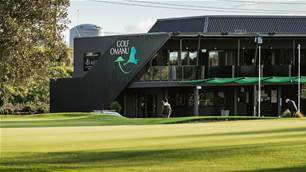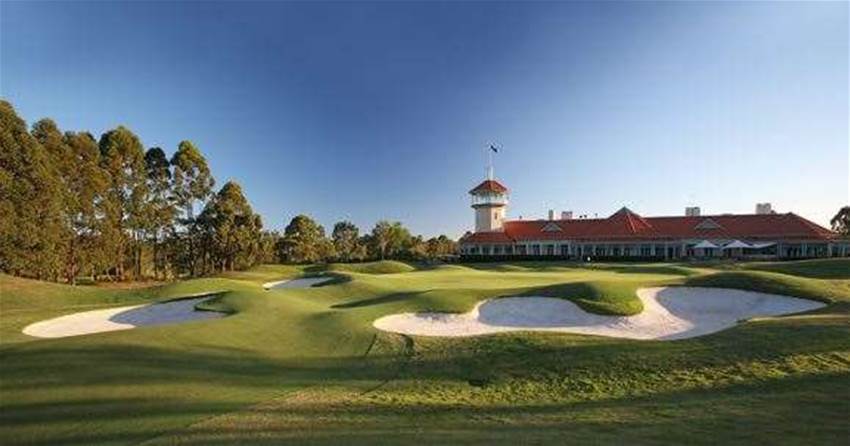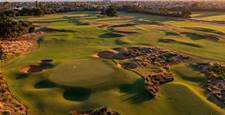After some tender loving care and added length, this bushland course has never looked better as its 20th birthday approaches.
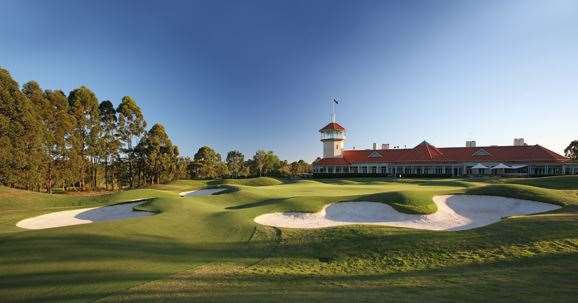
Terrey Hills has always been a private course in every sense of the word. The exclusive access is well-known but those who are unfamiliar with the location may be less aware of just how secluded the course’s setting is, which is a large part of its appeal. The course is still in suburbia – but only just, as it hugs the edge of Ku-ring-gai Chase National Park. The hustle and bustle of Australia’s largest city is only half an hour away and Sydney’s northern beaches are closer still. And therein lies the beauty of playing 18 holes at Terrey Hills, where you’re far enough out of town to escape the madness but near enough to it to remain within arm’s reach.
All of which isn’t to oversell the setting and undersell the golf course. Now almost 20 years old, the Graham Marsh/Ross Watson collaboration has been lauded from the start. When it opened for play in 1994, Terrey Hills was the newest course in Sydney for more than two decades, taking the dubious honour from nearby Wakehurst Golf Club, which opened in 1972. The transformed former quarry was immediately touted as a championship venue and it didn’t take long before the Tour came calling. The Canon Challenge gave touring pros their first look at the layout in 1995, with Terrey Hills playing host to the now-defunct tournament regularly throughout the second half of the 1990s. It’s often forgotten that the best female golfers in the land contested the 2003 Women’s Australian Open there, with two Brits – eventual winner Mhairi McKay and Laura Davies – fighting out the title.


It’s a pity such an ideal championship venue hasn’t seen more action in recent years, but pro golf’s loss is the Terrey Hillsmembers’ gain. The past four years have seen the club fortify its golf course, bringing the layout into the 21st century with modern length to stretch it within a pace of 6,500 metres from the back markers or 6,621 metres when five new ‘Tiger’ tees are in play at holes 2, 5, 10, 11 and 17. The club resurfaced all greens and green surrounds three winters ago, changing the putting surfaces from the original 1020 series bentgrass to an A1/A4 blend and the surrounds to Santa Ana couch. Prior to that the greenside bunkers were reshaped and rebuilt, returning them to the original design by removing the turf faces and instead using the sandy faces to heighten the visual impact. A similar renovation of all the fairway bunkers is next on the club’s golf course upgrade agenda.
The layout enjoys great balance. Its green complexes are familiar yet there’s an appropriate mix of bunkers, greenside water, humps, hollows and other pitfalls. The front nine is less open than the back but otherwise there is no sense of either side being longer, tougher or overtly different from the other. The best holes are also shared between the two halves.
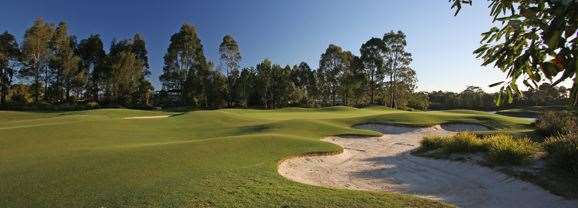
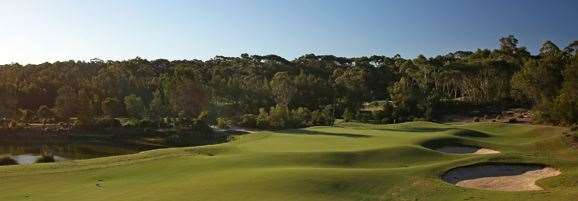
One of the better ones begins proceedings. The 492-metre 1st is an opportunity to get your round off to a flying start, as the par-5 tumbles downhill to a green fronted by a creek that trickles into a lake left of the green. The roomy putting surface creates a sense of safety for any shot that carries the trouble, even if two-putting from long range is anything but a certainty. I’ve always liked the 3rd hole, a 383-metre par-4 that also plays downhill with water left of the green, as well as the 5th, another par-4 where a big drive can bound across the top of the domed fairway.
The front nine closes with three holes that are strong for varying reasons. The 390-metre 7th is an exercise in precision as both the drive and, in particular, the approach must be pinpoint accurate. The fairway falls slightly to the right as it moves downhill and any drive straying too far right will finish in the rough on a sideslope and with the non-preferred angle into the green. Conversely, bunkers down the left are there to catch drives veering too far in the other direction. The green slopes steeply from back to front and missing left or right almost guarantees a bogey. The right side brings a deep bunker and a pond into play and while left appears to be the less penal direction to miss, any chip shot from below the green on that side is perilous.
The tee shot at the 349-metre 8th asks golfers to slot a drive long and over a series of bunkers that probe into the right side of the fairway or lay back with a long iron, leaving a mid-iron into a wide but shallow green with two distinct halves. The 9th is strong par-5 where there is ample space from the tee but the second shot must carry a fairway bunker to reach a downslope that will kick the ball towards the long green. That bunker atop the hill isn’t big but the terrain around it feeds balls inside it like a plughole swallows water.
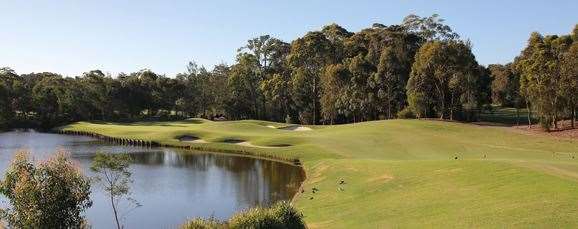
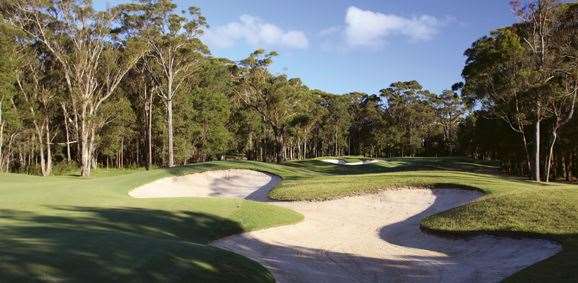
Three more strong par-4s characterise the inward nine. The 10th rewards a strong draw (for right-handers) from the tee with a shorter, simpler second shot but water lurks along the left side of the hole from the driving zone to the green. Any par earned on this 389-metre monster is well-earned. The next is an uphiller that extends to 435 metres from the aforementioned Tiger tee. The new starting point affords a better view of the hole ahead as some compensation for the added length. However the key to the 11th is in the second shot, which needs to be played with care depending on the hole location on the large green. There’s a pocket in the front-left corner of the putting surface that is tricky to get to thanks to the bunker short and left of the green, while water that’s not always visible beyond the surface can catch any shot flying past a rear flag.
The hole every golfer most wants to conquer at Terrey Hills is the 17th. This bruising par-4 is a brilliant examination of shot-making prowess. A right-to-left shot that turns with the gentle undulations of the fairway is ideal from the tee as anything loitering too far right risks finding sand, being shut out by overhanging tree limbs or both. The second shot requires the reverse – a controlled left-to-right shot that’s hard to execute from the opposing right-to-left camber – and is a shot made more difficult by the unmistakable presence of a large pond butting up to the right edge of the green. The putting surface is another large green with ‘pockets’ for the best hole locations, especially in the front right and back right. So shots that find the green safely can still leave dire putts over and across multiple ridges. No wonder this is rated as the toughest hole on the course.
The 18th isn’t the most memorable hole at Terrey Hills but the approach shot is beautifully framed by the huge clubhouse and requires a smartly shaped, high iron shot depending on where the flag is located.
Terrey Hills is largely a closed shop for non-members, however membership is currently open (see Fact File) and it is a popular corporate golf venue if you can wrangle your way into the field of one of the numerous corporate events held at the club.
THE COURSE
LOCATION: Booralie Rd, Terrey Hills. The club is a 30 to 40-minute drive north of the CBD and is best reached by taking Eastern Valley Way and Forest Way or via Mona Vale Rd. The club is about five minutes’ drive past the suburb of Terrey Hills.
CONTACT: (02) 9450 0155.
WEBSITE: www.terreyhillsgolf.com.au
DESIGNERS: Graham Marsh & Ross Watson (1994).
PLAYING SURFACES: A1/A4 bentgrass (greens), Santa Ana couch (green surrounds), Wintergreen couch (fairways and rough).
course superintendent: Stuart Gill.
PGA PROFESSIONALS: John Harrison (golf operations manager), Ben Doney (teaching professional).
THE CLUB
MEMBERSHIPS: Terrey Hills currently has 750 members with membership by way of transferable membership preference shares. The transfer facility has reopened and the club now has the opportunity to transfer a limited number of memberships, both private and corporate, to new members. Contact the membership department on (02) 9486 4119 for further details.
CORPORATE AND GROUP DAYS: Staging corporate events is restricted to members and corporate members of the club.
ACCOMMODATION: Checkers Resort & Conference Centre is a five-minute drive from Terrey Hills Golf & Country Club but has no official attachment to the club. Visit www.checkers.com.au or phone (02) 9450 2422 for more information.
Related Articles

Review: Omaha Beach Golf Club

Drinks With... Ricky Ponting
